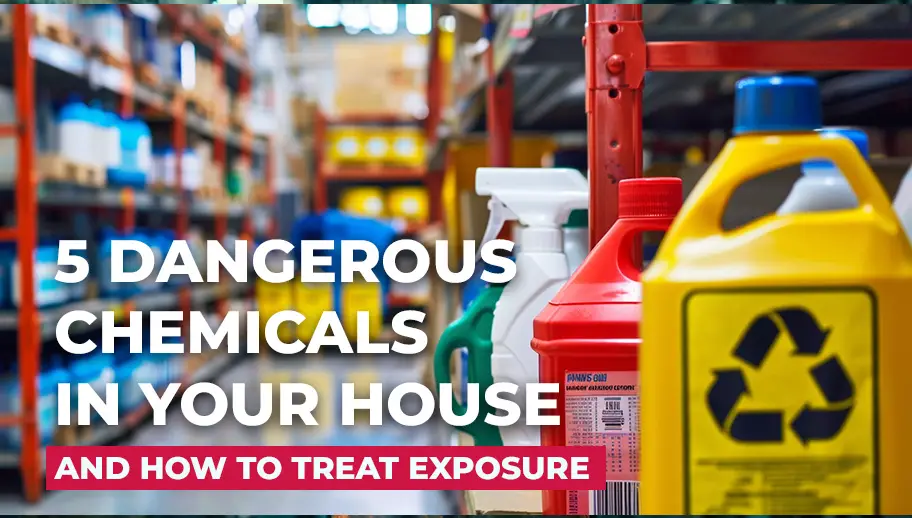5 Dangerous Chemicals in Your House and How To Treat Exposure


Within the comfort of your own home, there is a surprising amount of dangerous chemicals and substances that can cause severe damage to your health if you lack the knowledge of identifying and treating them. From battery acid to ones found in everyday cleaning products, acids can cause severe damage and must be treated cautiously. This article will provide an understanding of common household acids, their symptoms when they come into contact with the skin, appropriate first aid treatment, and when to seek medical assistance.
The first acid that is potentially harmful, and extremely common is Sulfuric Acid which is found in battery acid. This means it will be found in most batteries (A, AA, AAA, D, C, etc).
When it comes into contact with the skin it can cause a variety of symptoms such as burns, skin redness, pain, swelling, and potential chemical odour.
To treat contact, remove all contaminated clothing then, immediately wash the affected area with water for 15-20 minutes. If the burn is very large or deep or if the burn involves any sensitive parts of the body, like the face, hands, or genitals we recommend seeking medical attention.
Oxalic Acid is another very common acid as it is commonly found in many cleaning products. It is a good idea to check your cleaning products to know which ones contain oxalic acid.
Common symptoms of skin contact with oxalic acid include burns, redness of skin, pain, and chemical odour.
To treat, we recommend removing all contaminated clothing, then rinsing the burn for 15 minutes with water. We recommend seeking medical attention if the burn is very large or deep or if the burn affects any sensitive regions of the body, like the hands, face, or genitals.
This acid is yet another that is found in cleaning products within your own home. More specifically it is commonly found in toilet cleaners to help clean and kill bacteria.
Some symptoms of hydrochloric acid burn are scarring, redness, itching, and irritation.
To treat, rinse the burn for 10 minutes, then remove all contaminated clothing and apply a bandage to the burn. If available use a non-stick bandage and make sure to swap it with a new one twice per day.
Seek medical attention if the burn is extreme, or involves any sensitive areas (hands, feet, face etc).
Another very common household cleaning agent that contains potentially dangerous chemicals is bleach. Bleach is so strong it makes clothes lose colour if they come in contact.
The most common symptoms associated with bleach burns are redness, swelling, pain, and blistering.
To treat a bleach burn, immediately rinse the burn with water, then gently wash it with soap, and then wrap the burn up in a bandage. If available aim to use a non-stick bandage and make sure to change the bandage twice a day. We recommend seeking medical aid if the burn is extreme, very large, or is not improving with first aid.
We also recommend getting medical aid if there are lung symptoms (difficulty breathing, coughing, etc) from inhalation of bleach fumes.
Vinegar is the least potent acid on this list but is also one of the most common therefore it must be addressed.
Contact with skin can cause symptoms such as mild burns, irritation, redness, and pain.
To treat a burn on the skin caused by acetic acid, remove all contaminated clothing then, gently rinse the burn for 15 minutes. Seek medical attention if it is deep/large or the burn is not improving after treatment.

October 1, 2024
Almost every job involves using the body to carry out some type of manual task. Some tasks may be hazardous, causing injuries such as musculoskeletal disorders (MSDs). Knowing how to manage them is a legal responsibility of all workplaces.

January 10, 2024
In Australia, workplace safety is a top priority, and First Aid plays a crucial role in ensuring the well-being of employees. Workplaces are expected to adhere to specific regulations and guidelines outlined by Safe Work Australia. How does your workplace stack up?

November 24, 2023
No matter how experienced you are as an outdoor activity leader, there are some things you should always do to keep your group safe. Nature can be unpredictable, and so it’s best to be prepared.